2017 Trends in Garden Design
Garden and landscape designers across the country forecast noteworthy ideas shaping the gardening world in 2017See the new trends report: 2026 Trends in Garden Design
Dubbed the slowest of the performing arts, gardening can seem trend proof. After all, you can’t hurry an oak’s progress from acorn to shade tree, and making a garden isn’t like buying a new throw rug for your home but rather stitching a few glimmering threads of your own into nature’s rich tapestry. And yet tastes do change in gardening, as your once-obsessed African violet-growing parents or grandparents could tell you. Those who work with the buying public are especially attuned to what’s hot and what’s not. With that in mind, we asked designers and retailers across the country to share the biggest trends they anticipate for 2017. Here are 10 trends they say we’ll be seeing more of.
FREE GUIDE: How to Design Your Dream Garden
After years of minimalist dominance in hardscaping materials, furniture, and decor, designers are noticing renewed interest in natural materials and a less geometric style. Designer Julie Blakeslee, Big Red Sun, in Austin, Texas, says, “Rather than clean and modern, clients are asking for a more old-fashioned, more DIY look in their gardens. We’ve been using railway ties, free-form decks, smaller outdoor furniture, and swing seating. I think clients are looking for something more authentic and real. The Dwell look has been replicated so many times. People may be yearning for something more organic in their gardens.”
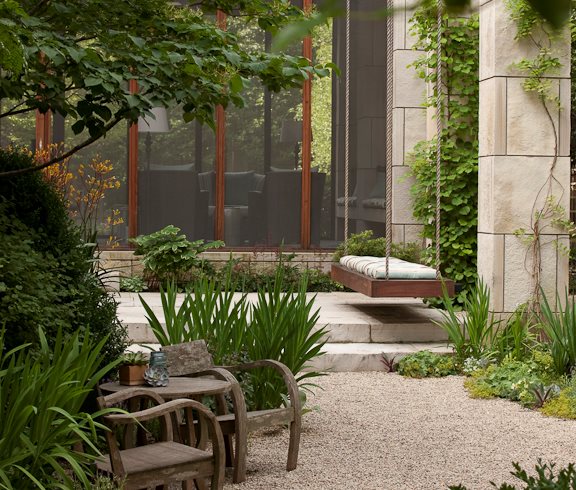
An ipe swing bench and curvy chairs along a winding gravel path make inviting spots for relaxation. Project by Hoerr Schaudt in Chicago, Il. Photo by: Scott Shigley.
Richard Hartlage of Seattle-based Land Morphology also sees a heightened interest in natural, tactile materials like wood and stone for the built elements of a garden. “People are moving away from concrete unless it’s an ultra-modern, minimalist garden,” he says.
A trend in women’s fashion, color blocking is the use of discrete blocks of colors, and it’s making a splash in outdoor living spaces too. Noting the number of color blocked patio walls that she’s seeing on Pinterest and around Los Angeles, Potted co-owner Annette Gutierrez says, “It’s about framing or highlighting a specific plant or area.” A flash of color on a wall, for instance, can frame a row of potted plants or be the artful backdrop to an outdoor sofa. “It’s exhilarating and oh so inexpensive to do!” she adds. And if you don’t have a wall to paint, you can always use a solid-color outdoor rug or porch curtains to create the effect.
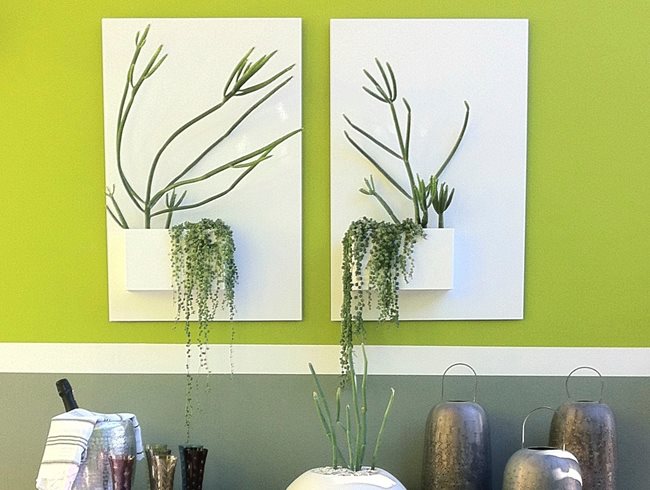
Blocks of chartreuse and sage green are set off with a crisp white stripe. Two white City Planters on the wall provide another block of solid color. Photo courtesy of Potted.
“Locally sourced” continues to be a buzzword in many industries, and garden designers too are seeing interest not just in native plants but endemic plants—those native to a very particular ecosystem. Tait Moring, a landscape architect who often designs ranch properties in central Texas, says, “We’re planting more local and endemic plants, not just natives.” These aren’t always readily available in the nursery trade, so he transplants existing plants where he can. Even building materials are sourced hyperlocally. “We use existing rocks and make posts from on-site junipers when possible.”
Such hyperlocalism is part of a trend that Susan Cohan, a New Jersey designer, calls a celebration of regionalism. Using native plants and locally sourced materials has been popular for years, she acknowledges. “What’s new,” she says, “is the impact that climate change is having on each region and how that drives design. More rain, drought, increased snowfall, no snowfall, cataclysmic weather events—these are all factors. Add local rules for impervious coverage, chemical runoff, and storm-water retention, and you have the basis for intense regional, even local, design qualities.” The designer's challenge, she says, has always been to find the balance between natural elements and human wants and use. “The answer to that challenge today is regionally focused design.”
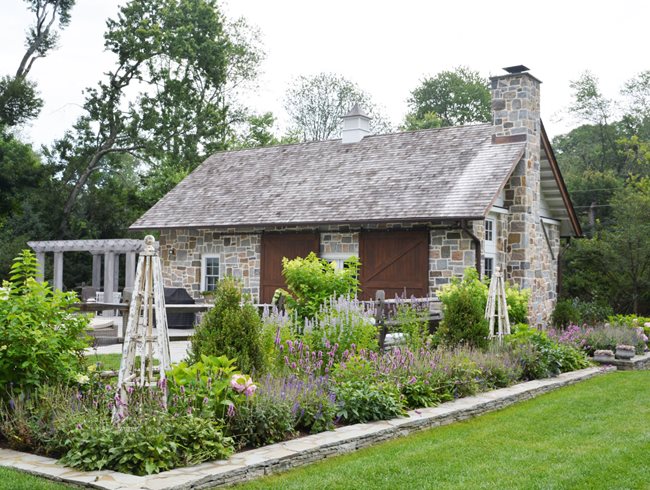
Sourcing materials locally helps reduce carbon emissions. This garden, designed by Susan Cohan, APLD, was created to reflect regional aesthetics and climate issues. Everything was sourced or grown locally. Native and non-native plants were chosen to survive active deer browsing and to actively encourage pollinators. Bluestone remainders from other parts of the project were incorporated as stepping and wall stones to reduce waste and the project's carbon footprint. Vintage elements add to the overall reuse of materials.
Long a symbol of the American dream, the expansive and neatly manicured lawn continues to take a hit, due in part to drought, water shortages, and concerns about the environmental impact of fertilizing, pest-control treatments, and other traditional maintenance. Lawn-like alternatives, however, are hot. “We’re installing a lot more grass mixes that don’t need to be mowed, like Habiturf [a native turfgrass blend for the Southwest], and also taller, prairie-type mixes,” says Moring. While he doesn’t anticipate the end of traditional lawns anytime soon, his clients who do want a lawn are opting for smaller ones than in the past. “These are lawns that will be used as opposed to being just for show,” he says.
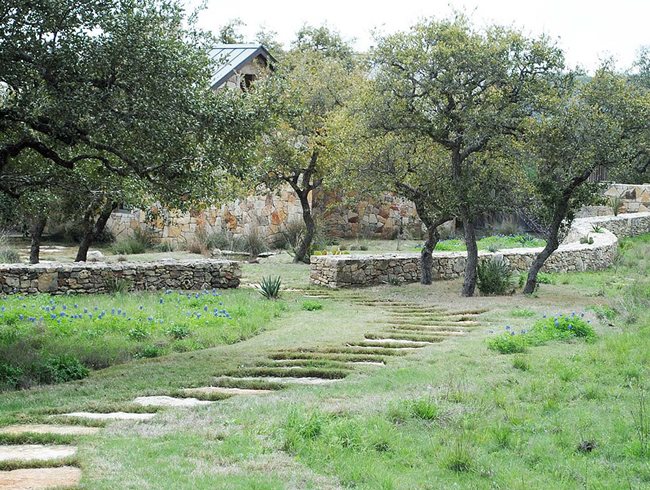
A short-grass meadow of native wildflowers and grasses reduces watering outside a serpentine limestone wall. Photo by: Tait Moring.
Despite controversy over its environmental impact, faux grass continues to grow in popularity, thanks to improvements in how natural it looks. “We are still installing a lot of artificial turf,” says Blakeslee in Austin. Designer Sue Goetz of Creative Gardener in Tacoma, Washington, is too, especially in small spaces that clients don’t want the bother of mowing and for pet play areas. “I have had more requests for artificial turf in the last year than ever,” Goetz says of her Washington clients, adding, “I’d always thought it was just a California thing.” She believes it has to do with how far the product has come in the last few years. “It looks and feels real. It also speaks to a desire for low maintenance.
Backyard homesteading has been going strong for a while, and edible gardens, chicken coops, and beehives are ubiquitous even in urban neighborhoods. The latest addition to the grow-it-yourself movement is natural dye gardens: plants used to make dyes for coloring textiles, yarn, and clothing. “Last year, I put in my first natural dye garden here in Berkeley,” says Leslie C. Bennett, owner of Pine House Edible Gardens in Oakland, California. “It's really beautiful and includes a lot of vegetables, fruit trees, and pollinator-attracting flowers, but we've selected varieties and quantities so that the harvests can be used for natural plant dyes as well.” Multiple recent books including Sasha Duerr’s Natural Color, Kristine Vejar’s The Modern Natural Dyer, and Chris McLaughlin’s A Garden to Dye For also attest to the growing interest in dye gardening.
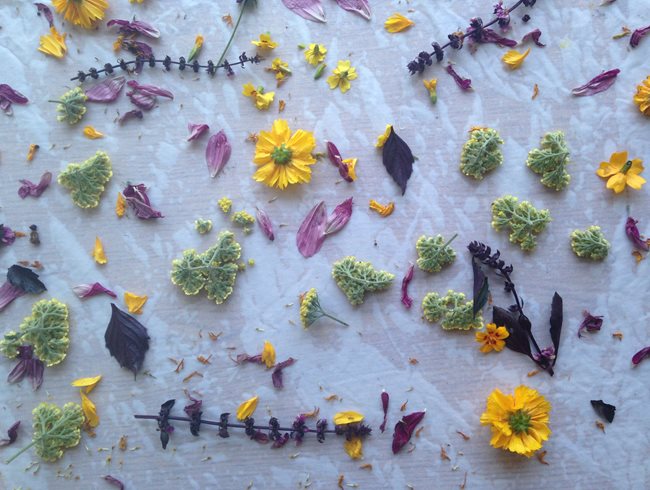
Just-harvested flowers are laid out on wet fabric as part of the dyeing process. Photo by: Jonny Thomas for Pine House Edible Gardens.
Bennett favors coreopsis, cosmos, Japanese indigo, marigold, ‘Moonshine’ yarrow, blue cornflower, and purple basil for making dyes. “Many of these are kitchen and cutting garden favorites too,” she points out. “So it’s pretty easy to integrate a natural dye garden into an edible garden.”
Choosing one style and sticking doggedly to it, whether modern or traditional, is passé, designers say. “Mixing old and new, a trend in interiors and architecture, is about to arrive in gardens,” says Hartlage. “It used to not be OK to mix styles, but now it’s acceptable. It’s not about modern or traditional anymore but how you combine the two in a compelling way, either by putting modern elements in a traditional garden or incorporating bold, traditional elements in a modern garden.”
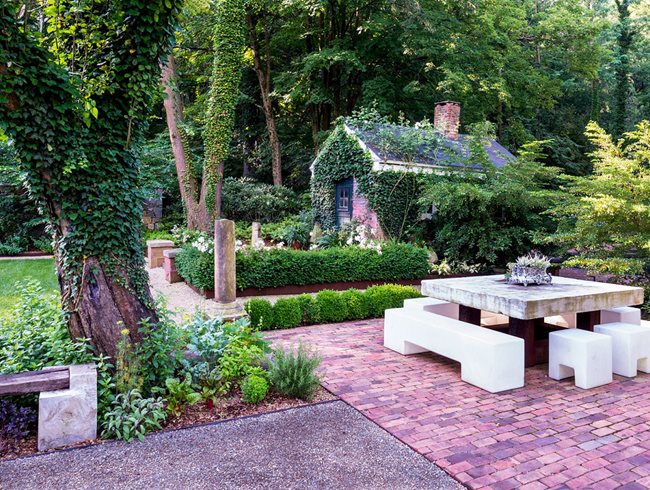
A modern table with bench seating offers a bold contrast to the traditional brick architecture of the outbuilding and brick patio. Photo by: Rob Cardillo, courtesy of Land Morphology.
Michelle Derviss, a designer based in Novato, California, also sees a blending of styles in “pairings of handmade artisan wares with a sleek modern design.” Eclecticism is not the goal, however, as Hartlage points out. Rather, mixing old and new without creating a mishmash is accomplished through the “thoughtful, intentional use of elements that contrast strongly with the predominant style.”
Active Play Spaces for All Ages
Playing out in the yard isn’t just for kids anymore, and even for kids it’s different. “I’ve had an uptick in requests for play and entertaining spaces,” says Goetz. “Bocce courts, dog and pet spaces, dining areas, fireplaces, hammocks. People don’t want places they have to weed. They want places where they can relax and play.” Susan Morrison, author and designer at Creative Exteriors Landscape Design in East Bay, California, agrees that game courts for adults and families are popular. “Most of my clients don’t have room for a regulation bocce court,” she says, “but I have done petanque courts and recently got a request for a cornhole court. Yes, there is a regulation size for cornhole!”
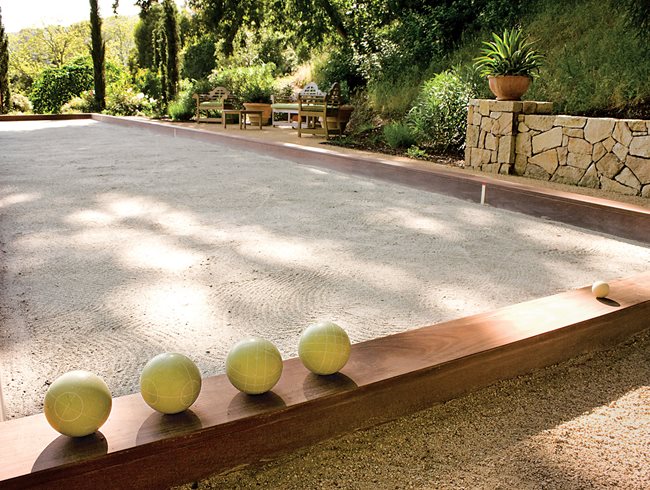
This court in Ross, California, was designed by David Brewer and features a traditional oyster shell surface. Photo by: Barbara Ries.
And after decades of plunking wooden climbing structures into their yards, parents today want designed spaces for their children that encourage imaginative play. “Families with young children are asking for active play spaces rather than traditional play structures,” Morrison says. “I’ve had four clients in the last year ask for spaces where their kids can create and build, rather than just climb on a play structure or dig in a sandbox. The idea is a free-form digging area intermixed with plants, rocks, and landscape ties. The organic shape means it can be better integrated with the rest of the garden than a stand-alone play structure can be.”
American yards are shrinking as houses grow larger on ever-smaller lots. Along with less space for plants, designers are hearing ever more requests for gardens that require little day-to-day maintenance. Dwarf shrubs to the rescue! “Baby boomers are aging, but they still love their gardens,” says Goetz. “We are finding creative ways to get rid of high maintenance, like using evergreen shrubs.”
Hartlage agrees. “Shrubs are strong due to their low maintenance needs,” he says, “and dwarf summer-blooming varieties are well suited to smaller gardens, like hydrangea ‘Bobo’ and ‘Little Quick Fire’. If you only need a 2-foot plant, why plant something that’ll grow to 4 feet and then spend the next 20 years clipping it? It’s all about plants that are the appropriate scale for the garden.”
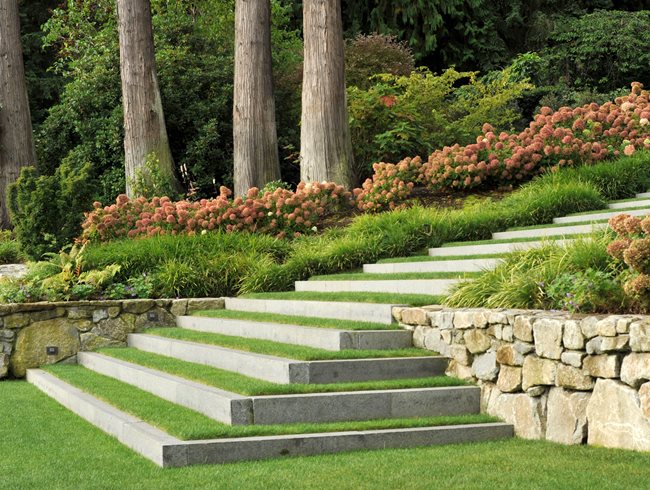
Showy dwarf hydrangea naturally stays low, making it a good fit for smaller gardens, and it doesn’t require much pruning. Photo courtesy of Land Morphology.
“Few gardeners have ‘from sea to shining sea’ to work with,” says Michigan designer Deborah Silver, who also owns Detroit Garden Works. “I see interest in columnar trees, understory trees, dwarf shrubs such as ‘Bobo’ hydrangea, dwarf perennials, and ground-hugging plants. The horticulture industry is working hard on developing plants that fit.”
Just as bell bottoms are reappearing on runways, a 1970s-style fascination with houseplants is back. Los Angeles designer and author Justina Blakeney’s hugely popular Instagram The Jungalow, for example, showcases rooms lush with potted greenery.
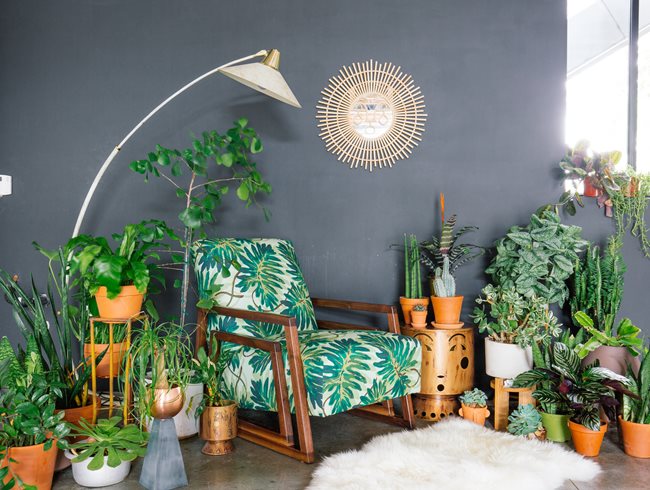
Fans of The Jungalow on Instagram go crazy for Justina Blakeney's interior designs which put houseplants front and center. For plant fans who don't happen to have green thumbs, check out the soon-to-be-released Justina for Jonathan Louis chair featuring plant prints. Photo by: The Jungalow.
“Bringing nature inside is definitely a trend we are seeing,” says Gillian Mathews, owner of Seattle’s Ravenna Gardens. And it’s not all retro either. “Whether it's a fiddle-leaf fig (the ‘it’ plant at the moment), a hanging kokedama, a Xerographica air plant, or a terrarium, we’re finding new and innovative ways to green up our homes and workplaces,” Mathews says.
Mary Gray, co-owner of Potted in Los Angeles, agrees. “We’re seeing a lot of young folks in their first dwellings coming in to select plants. Larger plants with presence such as fiddle-leaf fig, black ming aralia, and stumped schefflera are flying out the door. They are shopping for these plants and containers as they would furniture and home accessories. The pot and the plant are a significant contribution to their home aesthetic.” Mathews concurs that this trend is driven by younger gardeners, perhaps, she muses, as “a yin to the yang of their technology-driven world?”
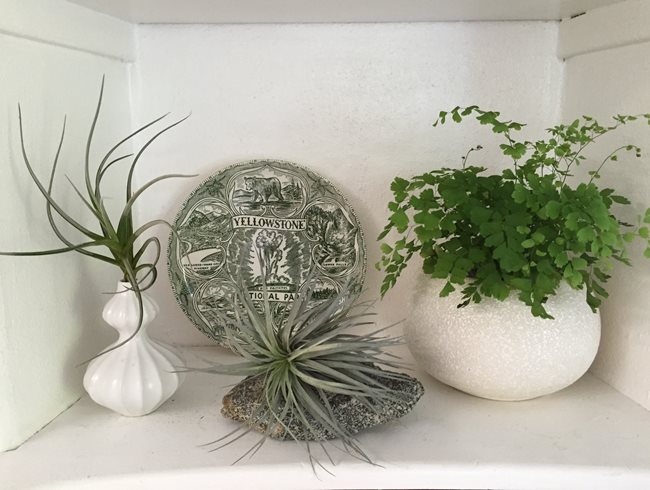
Tillandsias and maidenhair fern. Photo by: Mary Gray.
Tillandsias, the darling of trendy houseplant displays for the past several years, are opening the door to broader bromeliad experimentation, according to Derviss. “Those who have ventured into the world of tillandsias,” she says, “are finding that bromeliads are just as striking and fun to play around with.” Like their air plant cousins, bromeliads can be kept indoors and brought outside during the summer months (they must be protected from winter freezes). They mingle well with succulents or can be planted singly to show off their stiff, arching leaves and rich foliage color.
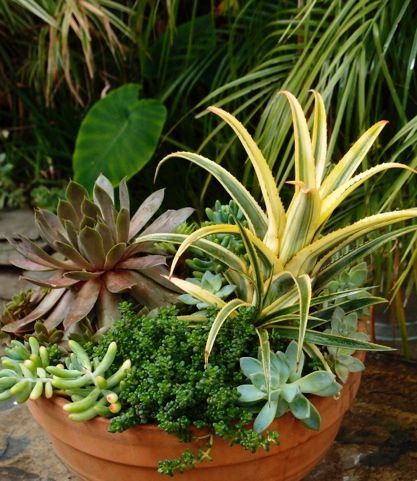
A striped ‘Aztec Gold’ bromeliad adds a dash of sunny color and strong form in a mixed-succulent planter. Photo by: Michelle Derviss.
“It’s amazing what you can do from your smart phone these days,” says Morrison. Ongoing droughts in California and throughout the West have galvanized an embrace of low-water landscaping, and technology advancements in irrigation systems make it easier than ever to control how much water is delivered to plants. “Smart controllers that use weather data to automatically determine correct irrigation amounts have been around for a while now,” Morrison says. “But the newest controllers like Hunter’s Hydrawise can be programmed and monitored from your phone. You can literally check on your irrigation system from your beach chair while you vacation! Some even include flow sensors that send a text alert if they detect a leak in the system and a portal so that your contractor can manage your irrigation remotely if you run into scheduling problems.”
Moring agrees. “We are seeing more advanced and efficient irrigation systems that can give a specific amount of water where it’s needed. It’s more expensive up front, but you can also create more zones so that specific plants can be watered more or less, depending on their needs.”
